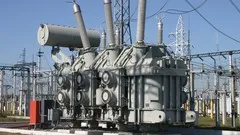
Power Engineering: Power System Analysis - Part 2 
This course is the second part of a multi-part series on power system analysis, a crucial aspect of power engineering. By learning about generators, transformers, and transmission lines, you will gain the necessary knowledge to pursue a career in power engineering and electrical engineering. Get a comprehesive understanding of this course which is a cost course. AZ Class provides this course data for free. Learn more certificate and details here. ▼
ADVERTISEMENT
Course Feature
![]() Cost:
Cost:
Paid
![]() Provider:
Provider:
Udemy
![]() Certificate:
Certificate:
Paid Certification
![]() Language:
Language:
English
![]() Start Date:
Start Date:
2023-04-01
Course Overview
❗The content presented here is sourced directly from Udemy platform. For comprehensive course details, including enrollment information, simply click on the 'Go to class' link on our website.
Updated in [October 18th, 2023]
What does this course tell? (Please note that the following overview content is from the original platform) This course is the second part of a multi-part course series about one of the main areas of electrical engineering: power system analysis Power system analysis is the core of power engineering and its understanding is therefore essential for a career in this field In this second course of the multi-part course series you will learn about generators electrical transformers and transmission lines and their use in power system analysis The course is divided into the following sections:1 Generator Models: in section 2 we will introduce the synchronous generator which is where all the power in power systems comes from Well begin by defining the circuit model of the synchronous generator so that we can analyze its performance We will then continue to discuss key concepts such as voltage regulation and the power angle and will end with several examples2 Transformer Models: in section 3 we will introduce the power transformer (also called electrical transformer) Transformers allow power systems to operate at different voltage levels and are an essential part of any power system We will begin by defining the equivalent circuit model of a power transformer and will then move on to discuss the approximate and simplified circuits We will also solve several examples along the way3 The Per-Unit System: in section 4 we will introduce the per-unit system The per-unit system is a technique used extensively in power system analysis and is therefore essential that it is understood This technique allows for the analysis of a power system which may have components operating at different voltage levels into one continuous circuit We will solve several examples to illustrate how the per-unit system can help with the analysis of power systems4 Transmission Line Models: in section 5 we will discuss the different transmission line models depending on their length as well as why these models are good approximations of real-life characteristicsIn each section several examples are solved to illustrate how to analyze real-world power systemsBy learning all the different circuit models of the components used in power systems you will be able to continue your study of power system analysis for a career in power engineering and electrical engineering Remember that Udemy offers a 30-day money-back guarantee I am also always available for questions while you go through the course to ensure everything is clearSee you in the course! We considered the value of this course from many aspects, and finally summarized it for you from two aspects: skills and knowledge, and the people who benefit from it: (Please note that our content is optimized through artificial intelligence tools and carefully reviewed by our editorial staff.) What skills and knowledge will you acquire during this course? Generator Models: Students will gain a comprehensive understanding of synchronous generators, which are the primary sources of power in electrical systems. They will learn how to define the circuit model of synchronous generators, analyze their performance, and grasp concepts like voltage regulation and power angles through practical examples. Transformer Models: The course delves into power transformers, explaining their significance in power systems and their ability to operate at different voltage levels. Students will learn to define equivalent circuit models for power transformers and explore approximate and simplified circuits, with problem-solving exercises. The Per-Unit System: Students will be introduced to the per-unit system, a critical technique in power system analysis. This system allows the seamless analysis of power systems with components operating at varying voltage levels, facilitating comprehensive circuit analysis. Practical examples will illustrate the utility of the per-unit system in power system analysis. Transmission Line Models: The course covers transmission line models and their suitability as approximations of real-world characteristics based on line length. It explains why these models are essential in power system analysis. Who will benefit from this course? This course on Power Engineering: Power System Analysis - Part 2 will benefit individuals interested in or pursuing a career in power engineering and electrical engineering. Specifically, it will be beneficial for: 1. Power Engineers: Power system analysis is the core of power engineering, and this course provides a comprehensive understanding of generators, transformers, and transmission lines. Power engineers will gain the necessary knowledge and skills to analyze and design power systems effectively. 2. Electrical Engineers: Understanding power system analysis is essential for electrical engineers working in the field of power distribution and transmission. This course will enhance their understanding of generators, transformers, and transmission lines, enabling them to contribute to the design and operation of power systems. 3. Power System Analysts: Professionals working as power system analysts will find this course valuable as it covers key concepts and techniques used extensively in power system analysis. The course provides insights into generator models, transformer models, the per-unit system, and transmission line models, allowing analysts to analyze and optimize power systems efficiently. 4. Students and Researchers: Students pursuing a degree in electrical engineering or power engineering will find this course beneficial for their academic studies. Researchers in the field of power systems can also gain valuable insights and knowledge from this course to support their research work. Overall, anyone interested in gaining a deep understanding of power system analysis and its components will benefit from this course, particularly those pursuing a career in power engineering and electrical engineering.
Course Syllabus
Course Introduction
Generator Models in Power System Analysis
Transformer Models in Power System Analysis
The Per-Unit System in Power System Analysis
Transmission Line Models in Power System Analysis
Course Exam
Bonus Section
Course Provider

Provider Udemy's Stats at AZClass
Discussion and Reviews
0.0 (Based on 0 reviews)
Explore Similar Online Courses

Power Engineering: Power System Analysis - Part 3

Substation Power Engineering Fundamentals

Python for Informatics: Exploring Information

Social Network Analysis

Introduction to Systematic Review and Meta-Analysis

The Analytics Edge

DCO042 - Python For Informatics

Causal Diagrams: Draw Your Assumptions Before Your Conclusions

Whole genome sequencing of bacterial genomes - tools and applications

Systems Innovation

power system analysis by Etap


Start your review of Power Engineering: Power System Analysis - Part 2